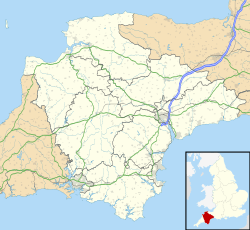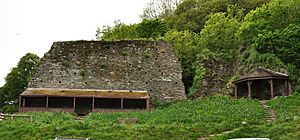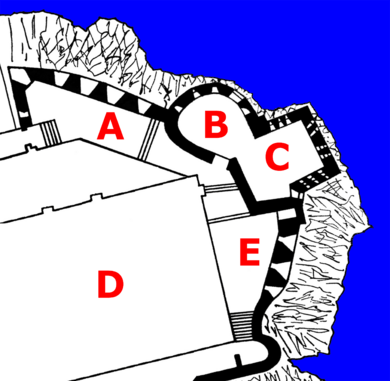Dartmouth Castle facts for kids
Quick facts for kids Dartmouth Castle |
|
|---|---|
| Dartmouth, Devon, England | |
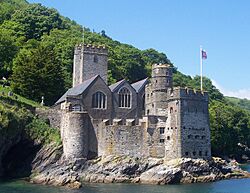
Dartmouth Castle, showing the 15th-century gun positions and St Petroc's Church
|
|
| Coordinates | 50°20′31″N 3°34′06″W / 50.34203°N 3.56829°W |
| Grid reference | grid reference SX885503 |
| Type | Artillery fort |
| Site information | |
| Owner | English Heritage |
| Open to the public |
Yes |
| Site history | |
| Materials | Limestone, slate |
| Events | English Civil War, World War II |
Dartmouth Castle is an old fort built to protect Dartmouth harbour in Devon, England. It's called an artillery fort because it was designed to hold powerful guns. The first parts of the castle were built in the 1380s. This was because people were worried about attacks from France.
The town leaders built a small castle overlooking the mouth of the River Dart. It was meant to fire at enemy ships using catapults and early cannon. A local church, Saint Petroc's Chapel, was even built inside its walls. Later, in the late 1400s, the castle got bigger. A special tower was added for cannons, and a huge iron chain could be stretched across the harbour. This was the first fort in Britain built just for coastal defence. More gun batteries were added in the 1540s when there was another fear of French invasion.
Dartmouth Castle was used during the English Civil War (1642-1646). During this time, people realised it was weak to attacks from the land. So, another defence called Gallants Bower was built on the hill above it. In 1748, a new gun area called the Grand Battery was added, with twelve guns. After being left alone for a while in the early 1800s, the castle was updated in 1859 with modern artillery. However, protecting Dartmouth was no longer a top military priority.
By the early 1900s, the castle was not needed for defence anymore. It was then opened to visitors. It was used again during the Second World War but was finally retired in 1955. Today, English Heritage looks after Dartmouth Castle. It's a popular place to visit, showing how people defended the coast long ago.
Contents
History of Dartmouth Castle
Early Days: 14th and 15th Centuries
Dartmouth Castle was built to protect the important harbour of Dartmouth. By the 1100s, Dartmouth was a busy port for trade and fishing. It could hold many ships. It was also known for piracy and privateering, especially attacking French ships.
In the 1370s, during the Hundred Years War, Dartmouth was a target for the French navy. The King often told the town to improve its defences. But nothing happened until 1388. That year, John Hawley, the mayor of Dartmouth and a privateer, got permission from King Richard II. He could raise money from the town to build a new "fortalice by the sea" to defend the harbour.
This "fortalice," or small fort, was like a small enclosure castle. It had a strong wall with mural towers and a gate tower. It was built on land belonging to the Carew family, who lent it because of the French threat. An old chapel to Saint Petroc was already there and became part of the fort. The fort had catapults to attack enemy ships. It might also have had early cannon and a chain to block the harbour entrance. The fort was not attacked, but it might have stopped a French attack in 1404. The Carew family later built a house inside the fort.
In 1481, King Henry VII talked with the town about its defences again. The King had agreed to pay Dartmouth £30 a year to keep a chain across the harbour. This agreement was ending soon, and the town wanted to continue it. Henry agreed to pay £150 over five years to build a new artillery tower. He also promised an annual payment of £30 for its upkeep, later increased to £40.
The new tower was built next to the old fort. It used stone from nearby towns and many stonemasons. The project took a long time. But fears of a French invasion grew in 1486. So, two large "murderer" guns were installed. By 1492, there were four "murderer" and twelve "serpentine" guns. The tower was finished in 1495. A strong chain linked it to a tower at Godmerock on the other side of the river. Another castle, Kingswear Castle, was also built by Dartmouth on the opposite side of the river.
From the 16th to 18th Centuries
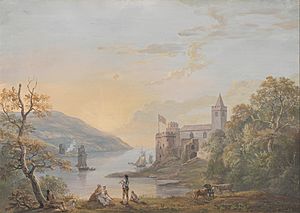
In 1543, King Henry VIII went to war with France. England was left open to a French invasion. So, Henry ordered improvements to the country's defences. Dartmouth Castle got three new gun batteries. One was on each side of the gun tower. Another, called Lamberd's Bulwarke, was in the south-east corner of the old fort.
Sir Peter Carew, a soldier and local Member of Parliament, didn't like this last addition. He said it was on his family's land inside the castle. He took over the castle and kicked out the town's officers. After a legal fight, the town got the property back in 1554. Carew returned in 1556 and took the castle again. Eventually, they agreed that the town would control the fort. The Carew family could still live in their house.
In 1597, with a threat of Spanish invasion, the gun tower was improved. Lamberd's Bulwarke was repaired. Two years later, a Spanish spy described the castle as having "24 pieces and 50 men." He said the harbour was well protected and the people were "warlike."
When the English Civil War started in 1642, Dartmouth first supported Parliament. The castle was guarded by five men. In 1643, Prince Maurice attacked the town. The castle was captured by artillery placed on the high ground behind it. An earthwork fort, Gallants Bower, was then built to protect this weak spot. In January 1646, Sir Thomas Fairfax led a Parliamentary army to retake Dartmouth. He captured the town, then Gallants Bower. The castle's commander, Sir Hugh Pollard, surrendered the next day. The Carews' house was likely damaged during the attack.
After the Civil War, Gallants Bower was closed down. But the castle stayed in use. The Carews' house was pulled down. A governor, Sir John Fowell, was put in charge of the castle. He also managed local defences and stopped smuggling. King Charles II became king in 1660. He first gave Dartmouth Castle back to the town. But by 1662, the fort was guarded by royal soldiers. Fears of Dutch and French attacks kept the castle active until the 1690s.
The castle was not well looked after in the early 1700s. A report in 1715 said it was "ruinous" and its guns were not maintained. A new threat from France led to more work. In 1741, Lamberd's Bulwarke was made stronger. In 1748, the government renamed it the Grand Battery. It became a two-level platform with twelve guns. The older parts of the castle were used for living and storage. Dartmouth's importance as a port began to decline. Nearby Plymouth took over much of its trade.
Modern Times: 19th to 21st Centuries
Dartmouth Castle was used during the Napoleonic Wars by volunteer soldiers. But it did not see any fighting. After the wars, the castle had fewer guns. Only one caretaker gunner remained. By 1820, only two guns worked. In 1847, a writer noted the castle was pretty but small, with only a few guns.
New types of guns and steam ships in the 1840s created a new risk of French attack. Worries about France grew in the 1850s. Also, new rifled cannons and iron-clad warships were developed. This led to a Royal Commission in 1859 that worried about the south coast's safety. As a result, the Grand Battery at Dartmouth Castle was rebuilt. It was renamed the Dartmouth Point Battery. It had strong granite defences to protect three large guns facing the sea. Two more large guns were on the roof. A smaller gun protected the harbour entrance.
The castle was staffed by professional soldiers and over fifty reservists. However, the castle was not a high military priority. It was only important because the harbour might be used to attack Plymouth. The guns it received were old-fashioned. An upgrade in 1888 also installed outdated artillery.
By 1909, most of the castle was considered old and useless for defence. The War Office gave it to the Office of Works. They restored it and opened it to visitors. It was used again during the Second World War. It was armed with two quick-firing guns to protect merchant ships and a local shipyard. British Army soldiers manned the castle.
In 1955, the castle was given back to the Ministry of Works and repaired. The Dartmouth Point Battery, now called the Old Battery, was rented out as a restaurant. The site was reopened to the public. Today, English Heritage manages Dartmouth Castle. The Grand Battery is shown as it looked in the 1800s. The 14th-century gun tower is a Grade I listed building, meaning it's very important. The 19th-century gun battery is a Grade II* listed building.
Castle Design and Features
Dartmouth Castle sits on a rocky point, looking over the entrance to Dartmouth harbour. On the north side is the main gun tower, facing the River Dart. Next to it is Saint Petrox Church. To the south-east is the Old Battery, facing the sea. In the south-west corner are the remains of the first fort. These include a corner tower, part of the moat, and parts of the wall. The wall is about 2.3 metres (7.5 feet) thick and up to 7 metres (23 feet) high.
The gun tower was built in the late 1400s. It is the oldest fort in Britain built just for coastal artillery. The tower has three floors. One part is semi-circular and made of limestone rubble. This part held the machinery for the harbour chain. The other part is square and made of slate. This part held the guns. Each floor has two main rooms, one round and one rectangular. This design probably changed during construction.
Originally, the basement held the castle's artillery guns. These had simple gun-ports, covered by wooden shutters. The ground floor rooms were offices and living spaces for the soldiers. They also held the chain room, with a pulley and capstan to raise the chain defence. The first floor was used for sleeping and had an oven. Small openings called Gunloops for handguns were on all floors for close defence. Lighter artillery would have been on the roof. The roof's battlements were made taller after the castle was built. This was to protect against musket fire from the higher ground behind the castle. A 5.5-metre (18-foot) high turret rises above the roof.
Two gun platforms from the mid-1500s are on either side of the main gun tower. They were changed in the 1700s for newer artillery. Just behind the gun tower is Saint Petrox Church. This church has three aisles and dates to 1641. It was restored in 1833.
The Old Battery dates from 1861. It was once called the Dartmouth Point Battery. It sits where the Grand Battery and Lamberd's Bulwarke used to be. On the north-east side is a guard room, above the magazines (where ammunition was stored). It was protected from land attacks by a ditch, rifle-loops, and murder-holes. The main part of the battery has three vaulted casemates. These held heavy guns that pointed out to sea. A smaller gun position covered the harbour entrance. Two more heavy guns would have been on the roof. A white concrete building, once a hidden gun position, is now the ticket office. Behind the Old Battery is a 19th-century tower that was a lighthouse from 1856 to 1886.
Dartmouth Castle in Art
Letitia Elizabeth Landon wrote a poem called Dartmouth Castle in 1833. It went with a picture by Thomas Allom showing the Castle and Harbour. The poem talks about how the castle, once a place of war, became a holiday spot.
See also


